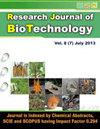Endotoxin lipopolysaccharide (LPS)-induced peripheral inflammation and its impact on brain and liver function
IF 0.2
Q4 Biochemistry, Genetics and Molecular Biology
引用次数: 0
Abstract
Endotoxin Lipopolysaccharide (LPS) induces an innate immune response and activates sickness behavior. During neuroinflammation, the activated microglial cells change its morphology and release various chemicals that could be harmful such as nitric oxide (NO), reactive oxygen species (ROS) and enzymes for proteolysis. Through the buildup of free radicals and ROS, these neuroinflammations can also result in oxidative stress. This ROS reacts with cellular macromolecules, triggering a cascade that results in membrane porosity caused by membrane lipid peroxidation (LPO), which is measured by the quantity of malondialdehyde (MDA). On LPS challenge, the complex behaviour that decreased common activities and explorations, is noticed and with rising anxiety, cognitive impairment and decreased social activities. It also decreased closed arm time, although closed arm entries were higher which may be related to the increased locomotion. It raised open arm time and open arm entries, suggesting of reduced anxiety and also increased exploratory behaviour. AChE and nNOS were increased in the forebrain part. Reduction in brainstem and MDA activity decreased on both forebrain and brain stem. MDA in the liver increased by LPS challenge indicating upregulated hepatic tissue damage and oxidative stress. As a result of LPS-induced lipid peroxidation and oxidative stress, brain Glutathione (GSH), a substrate for cytosolic Glutathione peroxidase, increased in the forebrain and decreased in the brainstem. Decreased scavenging of ROS was indicated by the LPS-induced decrease in liver GSH levels.内毒素脂多糖(LPS)诱导的外周炎症及其对脑和肝功能的影响
内毒素脂多糖(LPS)诱导先天免疫反应并激活疾病行为。在神经炎症期间,被激活的小胶质细胞改变其形态并释放各种可能有害的化学物质,如一氧化氮(NO)、活性氧(ROS)和蛋白质水解酶。通过自由基和活性氧的积累,这些神经炎症也会导致氧化应激。这种ROS与细胞大分子反应,触发级联反应,导致膜脂过氧化(LPO)引起的膜孔隙,这是通过丙二醛(MDA)的量来测量的。在LPS挑战下,常见活动和探索减少的复杂行为被注意到,并伴有焦虑、认知障碍和社交活动减少。它也减少了闭臂时间,尽管闭臂进入时间较高,这可能与运动增加有关。它增加了张开手臂的时间和张开手臂的次数,表明焦虑减少了,探索行为也增加了。前脑区AChE和nNOS升高。脑干的减少和MDA活性在前脑和脑干均下降。LPS刺激导致肝脏MDA升高,表明肝组织损伤和氧化应激上调。作为脂质过氧化和氧化应激的结果,脑谷胱甘肽(谷胱甘肽过氧化物酶的一种底物)在前脑增加,在脑干减少。脂多糖诱导的肝脏GSH水平下降表明活性氧清除能力下降。
本文章由计算机程序翻译,如有差异,请以英文原文为准。
求助全文
约1分钟内获得全文
求助全文
来源期刊

Research Journal of Biotechnology
工程技术-生物工程与应用微生物
CiteScore
0.60
自引率
0.00%
发文量
192
审稿时长
1.5 months
期刊介绍:
We invite you to contribute Research Papers / Short Communications / Review Papers:
-In any field of Biotechnology, Biochemistry, Microbiology and Industrial Microbiology, Soil Technology, Agriculture Biotechnology.
-in any field related to Food Biotechnology, Nutrition Biotechnology, Genetic Engineering and Commercial Biotechnology.
-in any field of Biotechnology related to Drugs and Pharmaceutical products for human beings, animals and plants.
-in any field related to Environmental Biotechnolgy, Waste Treatment of Liquids, Soilds and Gases; Sustainability.
-in inter-realted field of Chemical Sciences, Biological Sciences, Environmental Sciences and Life Sciences.
-in any field related to Biotechnological Engineering, Industrial Biotechnology and Instrumentation.
-in any field related to Nano-technology.
-in any field related to Plant Biotechnology.
 求助内容:
求助内容: 应助结果提醒方式:
应助结果提醒方式:


